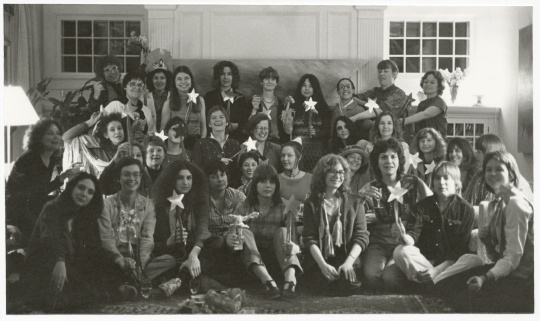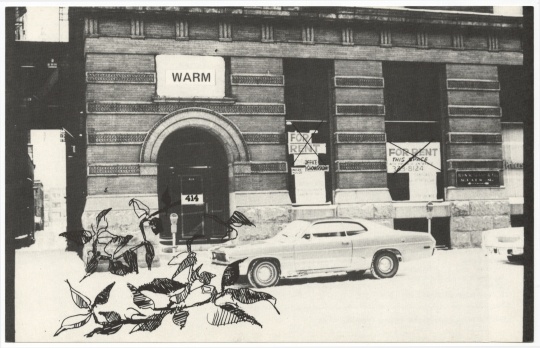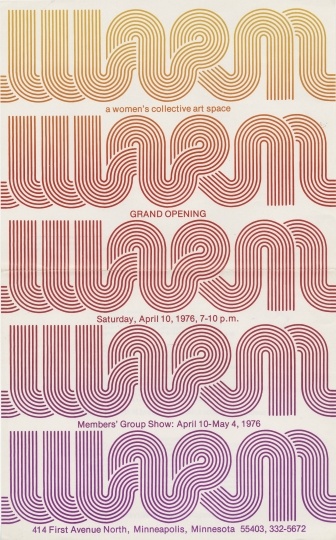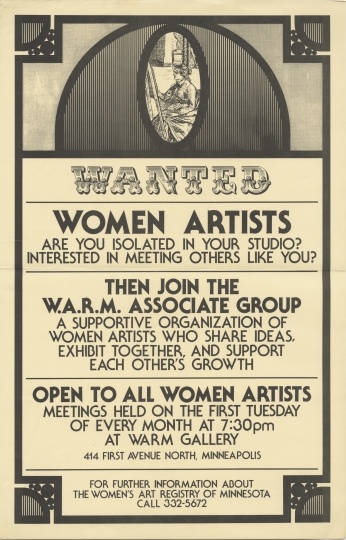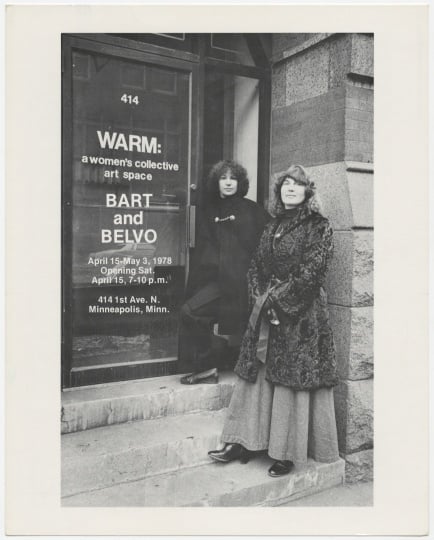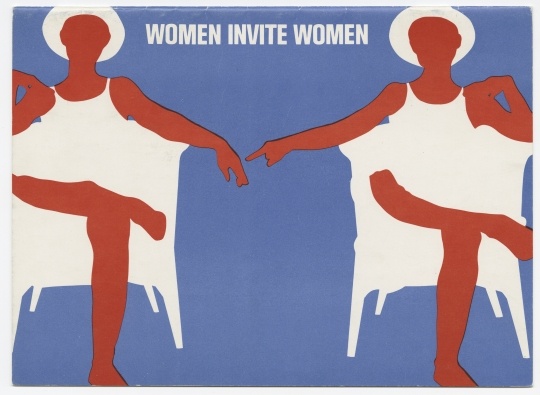In 1976, the doors opened to a new art gallery—the first in Minnesota dedicated exclusively to women artists. During its fifteen years of operation, WARM: A Women’s Collective Art Space (often referred to as the WARM Gallery) was at the center of women’s visual arts programming in the Twin Cities. Informed by second-wave feminism and in step with the national Women’s Art Movement, the WARM Gallery built a new arts community focused on promoting equality. It gave women artists the professional experiences necessary to compete in the art world and provided public access to women’s art, history, and theory.
The Women’s Art Registry of Minnesota (WARM) began in 1973 as a group dedicated to increasing public access to art made by women and creating opportunities for women artists. Membership was fee-based and open to any woman artist in the state. In its earliest years, WARM achieved its goals in two ways. First, the group arranged art exhibits at galleries, colleges, and public spaces. Second, it formed a slide registry. This registry functioned like a library of images of the members’ artworks and was made available to curators, collectors, educators, and the general public. Users could browse through the slides in person, request copies by mail, or see projections at monthly curated viewings. Because of these activities, word spread quickly about the group, and WARM’s membership and supportive community grew.
Opening a gallery space was a natural extension of the group’s goals. By January 1976, a lease for a street-level space in the Wyman Building in Minneapolis (414 First Avenue North) was signed, and renovations began. Thirty-seven WARM members became WARM Gallery collective members. They put in hundreds of hours of work to convert the space from a dark, dingy garment workshop to a pristine, white-walled exhibition space.
WARM: A Women’s Collective Art Space opened to the public on April 10, 1976, with an exhibition of the members’ artwork and a celebration that drew more than 1,500 visitors. Renowned feminist artist Miriam Shapiro attended. When interviewed for a Minneapolis Star Tribune article, Shapiro praised the gallery, saying “that it is the most elegant of the five such collective art galleries in the United States and that it is very professional.”
The gallery functioned as a base of operations for WARM’s activities. They included meetings, slide registration, performances, lectures, parties, classes, and collaborations with outside artists, museums, galleries, theaters, and arts organizations. During the gallery’s first ten years, members launched a slide- and tape-rental program featuring the scholarly and historical work of members and collaborators. They curated an invitational gallery featuring works by Joan Snyder, Harmony Hammond, and many others, and organized an outside exhibition program that promoted the work of members throughout Minnesota and beyond. Other achievements included a feminist art journal with over 5000 subscribers; an acclaimed mentor program; a feminist art lecture series with speakers like Grace Hartigan, Bettye Saar and Alice Neel; and a national conference, The Contemporary Woman in Visual Arts, with over 400 scholars and artists.
These ambitious activities were coordinated exclusively by WARM members and gallery members and were partially or fully funded by grants and outside donors. Often, grants came with stipulations that funds could not be used for day-to-day operating costs. The WARM Gallery’s operation costs were therefore funded primarily by its collective membership. Because members rejected the commercial gallery model, sales of artworks went directly to the artists. Other income came from journal subscriptions, multiple levels of memberships, and outside donors.
Around 1987, gallery membership changed as many of its founders left to pursue other opportunities and the next generation of artists joined. This shift, coupled with a growing operational debt and funding shortfalls, led to the closing of the gallery space in 1991. WARM continued, however, as a members-only group. It changed its name to The Women’s Art Resources of Minnesota and focused on the mentor program and outside exhibitions.








